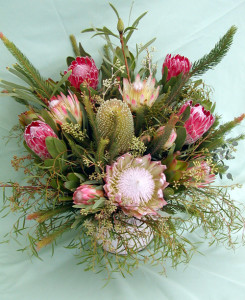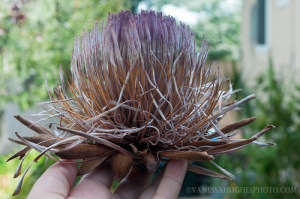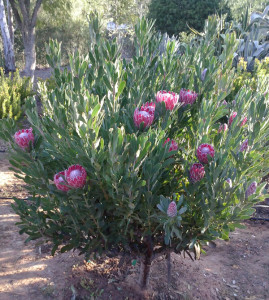For maximum vase life, care for these exotic blooms as follows: Cut about 1/4 inch from the end of the stem, strip all leaves which would be below the surface of the water and place it in a vase with water and approximately 1/4 teaspoon of household bleach per quart of water as soon as you get them home. The bleach will prevent the growth of algae in the water which will clog the water channels in the stem. If you repeat this at 4 to 5 day intervals and keep them out of the direct sunlight they will keep their fresh look much longer.
Don’t throw them away! Most Protea will dry without shedding leaves or petals. They will take a different form which may be readily used in dried flower arrangements which will last for many years. Some of the color will remain but mostly they will go to tan shades.
When the blooms have reached the end of their fresh life just remove the water and put them in an out of the way place for about three weeks. You may stand them in a bucket or vase or hang them upside down, but don’t lay them on a flat surface or in a pile or they will assume an unnatural shape. You may remove the leaves or keep them on to attain the desired effect. You will then have dried flowers which can be arranged with other dried materials to create unusual and attractive decorations for your home.
Proteas can be grown in climate zones as defined in Sunset Garden Book 21, 22 and 23 are generally acceptable except for cold spots in low lying areas. For zones 19, 20 and 21 plant on high ground only. Protea can survive for two (2) hours down to 28 degrees F. with minor new leaf damage. Ideally Proteas thrive in well-drained soil such as decomposed granite, in full sun with good air circulation. Do not plant them in areas, which have been fertilized with phosphorous or old grove areas contaminated with Phytopthera Cinnamoni. Generally speaking, avoid planting them with other garden flowers, which need continuous damp soil and phosphorous bearing fertilizers. Virgin soil with native brush in place is ideal.
When?
Generally it is best to plant in the fall and winter from November through February.
How?
Obtain plants in one (1) gallon cans, dig a hole three (3) times the can diameter and three (3) times the depth. Space the Protea plants about six (6) feet apart, Banksias six (6) to ten (10) feet apart depending on the mature size of the plant. Avoid holes with rock bottoms, drainage is vital. Fill the hole with water and let it soak in. Back fill the hole raking in any rotted vegetable matter around the hole and place the plant with the original soil level even or a little above the surrounding soil level. Tamp the soil down with your hand and add more water to the area around the plant.
Water
Proteas like to have wet-dry cycles so set them up with a drip system and water them once a week with approximately one (1) gallon of water each week during cool months and more during the hot, summer months. One (1) dripper about two (2) inches from the stem will be adequate until the plants mature, then add a dripper on each side about six (6) inches from the stem and remove the original dripper. One (1) gallon per hour drippers are generally used.
Fertilizer
It is best not to fertilize Proteas as they have evolved in poor nutrient areas. DO NOT apply any fertilizer with phosphorous or ammonium nitrate type fertilizer. If you feel a vital need to fertilize, use a small amount of ammonium sulphate dissolved in water.
Just starting out?
Check out our Beginners Guide:




